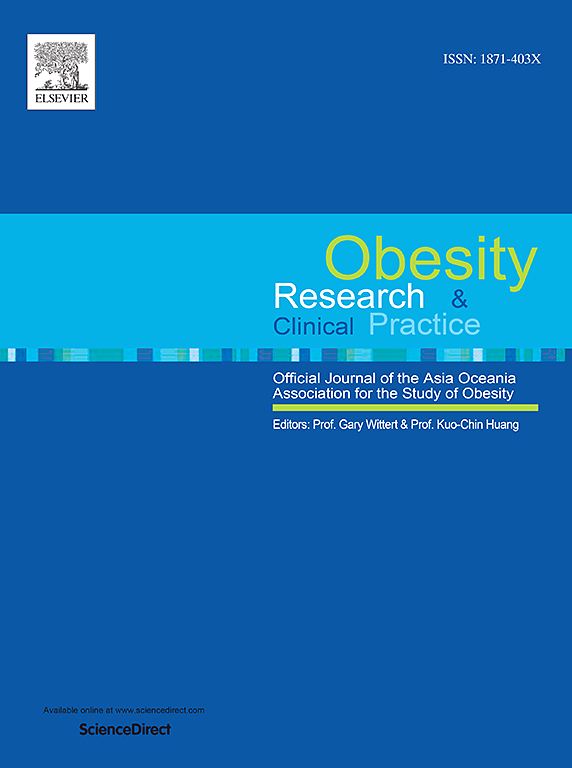一项横断面研究:探讨丹麦年轻超重女性高血糖的患病率及其与身体健康的关系。
IF 2.5
4区 医学
Q3 ENDOCRINOLOGY & METABOLISM
引用次数: 0
摘要
背景:20岁诊断为2型糖尿病(T2D)与预期寿命减少17.9年相关。随着年轻人中超重患病率的增加,我们的目的是评估丹麦超重或肥胖的年轻女性中T2D和中度高血糖的患病率,这些女性以前没有被诊断为T2D。此外,我们旨在研究高血糖标志物(葡萄糖耐量、空腹血糖、胰岛素和HOMA-IR)、身体成分、身体健康和其他生活方式因素之间的关系。方法:在这项多中心横断研究中,我们纳入了111名年龄在18-30岁之间,BMI为> 25 kg/m2的女性,她们很少或没有定期的体育活动。参与者进行了口服葡萄糖耐量试验,并获得了空腹血液样本,并分析了空腹血糖、胰岛素和血脂。其他结果包括测量人体测量和身体成分(DXA)、身体活动水平(PAL)、身体健康(Aastrand’s bike test)、握力和反动作跳跃。通过4天的饮食记录估计膳食摄入量,通过食物频率问卷估计钙摄入量。结果:在BMI为30.9 ± 4.8 kg·m-2的女性(24 ± 3岁)中,19.8 %归类为中度高血糖,2.7 %归类为T2D,尽管之前没有糖尿病诊断。高血糖指标与PAL和身体健康呈负相关,与BMI和脂肪量呈正相关。结论:在一组超重或肥胖且未被诊断为T2D的年轻女性中,五分之一的人表现出中度高血糖,这与低体质和高BMI有关。本文章由计算机程序翻译,如有差异,请以英文原文为准。
Exploring the prevalence of hyperglycemia and the link to physical fitness in young Danish women with overweight – A cross-sectional study
Background
Diagnosis of type 2 diabetes (T2D) at 20 years of age is associated with a reduction in life expectancy of 17.9 years. With an increasing prevalence of overweight among young people, we aimed to assess the prevalence of T2D and intermediate hyperglycaemia among young Danish women with overweight or obesity, who had not been previously diagnosed with T2D. Furthermore, we aimed to examine associations between markers of hyperglycaemia (glucose tolerance, fasting glucose, insulin, and HOMA-IR), body composition, physical fitness, and other lifestyle factors.
Methods
In this multicentre, cross-sectional study, we included 111 women aged 18–30 years with BMI> 25 kg/m2 who engaged in little or no regular physical activity. Participants underwent an oral glucose tolerance test and fasting blood samples were obtained and analysed for fasting glucose, insulin, and lipids. Other outcomes included measurements of anthropometry and body composition (DXA), physical activity level (PAL), physical fitness (Aastrand’s bike test), hand grip strength, and countermovement jump. Dietary intake was estimated through 4-day dietary records, and calcium intake was estimated through food frequency questionnaires.
Results
Among women (24 ± 3 years) with a BMI of 30.9 ± 4.8 kg·m-2, 19.8 % were classified with intermediate hyperglycaemia and 2.7 % with T2D, despite no previous diabetes diagnosis. Markers of hyperglycaemia were inversely associated with PAL and physical fitness and positively associated with BMI and fat mass.
Conclusion
In a cohort of young women with overweight or obesity, not previously diagnosed with T2D, every fifth exhibited intermediate hyperglycaemia, which was linked to low physical fitness and high BMI.
求助全文
通过发布文献求助,成功后即可免费获取论文全文。
去求助
来源期刊

Obesity research & clinical practice
医学-内分泌学与代谢
CiteScore
7.10
自引率
0.00%
发文量
80
审稿时长
49 days
期刊介绍:
The aim of Obesity Research & Clinical Practice (ORCP) is to publish high quality clinical and basic research relating to the epidemiology, mechanism, complications and treatment of obesity and the complication of obesity. Studies relating to the Asia Oceania region are particularly welcome, given the increasing burden of obesity in Asia Pacific, compounded by specific regional population-based and genetic issues, and the devastating personal and economic consequences. The journal aims to expose health care practitioners, clinical researchers, basic scientists, epidemiologists, and public health officials in the region to all areas of obesity research and practice. In addition to original research the ORCP publishes reviews, patient reports, short communications, and letters to the editor (including comments on published papers). The proceedings and abstracts of the Annual Meeting of the Asia Oceania Association for the Study of Obesity is published as a supplement each year.
 求助内容:
求助内容: 应助结果提醒方式:
应助结果提醒方式:


